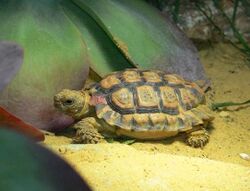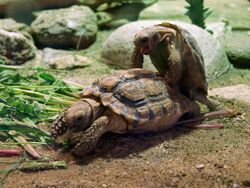Biology:Homopus signatus
| Homopus signatus | |
|---|---|

| |
| Scientific classification | |
| Domain: | Eukaryota |
| Kingdom: | Animalia |
| Phylum: | Chordata |
| Class: | Reptilia |
| Order: | Testudines |
| Suborder: | Cryptodira |
| Superfamily: | Testudinoidea |
| Family: | Testudinidae |
| Genus: | Homopus |
| Species: | H. signatus
|
| Binomial name | |
| Homopus signatus | |
| Synonyms[7] | |
Homopus signatus is the world's smallest species of tortoise (family Testudinidae). The species is commonly known as the speckled tortoise[1][8] and also known locally as the speckled padloper[1][9] and internationally as the speckled Cape tortoise.[1] A member of the genus Homopus, it is endemic to South Africa .[9]
Distribution and subspecies
H. signatus is naturally restricted to a small area in Little Namaqualand, an arid region in the west of South Africa, where it normally lives on rocky outcrops and forages among the rocks for the tiny succulent plants it eats.
In the past, two subspecies were recognized, the Namaqualand speckled padloper (H. s. signatus) and the southern speckled padloper (H. s. cafer), but genetic studies have determined this was not supported and they are now considered a single species.[10][7]
Description
The males of H. signatus measure 6–8 cm (2.4–3.1 in) in straight carapace length, while the larger females measure up to almost 10 cm (3.9 in);[11] they weigh about 95–165 g (3.4–5.8 oz). This species has a flattened shell with slightly serrated edges. The orange-brown shell is covered in hundreds of black spots. The males have a noticeably concave belly.
This tiny tortoise can be distinguished from the other Homopus species by its speckles, and by five toes on its fore feet (unlike many of its relatives, which have four toes on all four feet).[12]
Lifecycle and behaviour
Speckled padlopers are most active in the early morning (especially in autumn and spring, when they breed). Living among the rocky outcrops, they feed on small succulents which grow between the rocks, and which they are small enough to reach. Their courtship involves the male and female nodding their heads at each other. After mating, the female makes a nest of several eggs in damp soil between the rocks. The hatchlings are under 7 grams and 30 mm (1.2 in) long, and emerge after 100 to 120 days.[13]
Threats and conservation
H. signatus is threatened by traffic on roads, habitat destruction, and poaching for the pet trade. As the trade in collected Homopus species is strictly illegal and any captive specimens are systematically registered in noncommercial studbooks in South Africa and Namibia, any commercial sale of Homopus tortoises is almost without exception strictly illegal. Another threat comes from introduced species, such as domestic dogs and pigs.[14][15][16][17]
Many are taken from their natural habitat each year, and nearly all subsequently die as a result, as they do not readily adapt to typical captive diets and environmental change. Unlike most other Homopus species, however, their diet (while very varied) is not highly specialized. Therefore, the species can adapt well to captivity, provided that proper attention is paid to temperature, humidity, and a sufficiently varied diet. They can be very hardy in captivity, and most problems with captive care are caused by faulty nutrition, high humidity, dampness, or bad husbandry.[18][19][20]
References
- ↑ 1.0 1.1 1.2 1.3 Template:IUCN
- ↑ 2.0 2.1 Gmelin, Johann Frederic (1789). Caroli a Linné, Systema Naturae per regna tria naturae secundum classes, ordines, genera, species, cum characteribus, differentiis, synonymis, locis. Ed. 13. Tom. I. Pars III. Leipzig: G.E. Beer, Ed. 13, 1 (3): 1033–1516. (Testudo signata, new species, p. 1043). (in Latin).
- ↑ Walbaum, Johann Julius (1782). Chelonographia oder Beschreibung einiger Schildkröten. Lubeck: J.F. Gleditsch, 132 pp. (in German).
- ↑ Daudin, François Marie (1801). Histoire Naturelle, Générale et Particulière des Reptiles. Tome Second. Paris: Imprimerie F. Dufart. 432 pp. (in French).
- ↑ Daudin, François Marie (1802). Histoire Naturelle, Générale et Particulière des Reptiles. Tome Quatrième. Paris: Imprimerie F. Dufart. 397 pp. (in French).
- ↑ Hewitt, John (1935). "Some new forms of batrachians and reptiles from South Africa". Records of the Albany Museum 4: 283–357.
- ↑ 7.0 7.1 Turtle Taxonomy Working Group [van Dijk, P.P., Iverson, J.B., Rhodin, A.G.J., Shaffer, H.B., and Bour, R.]. 2014. Turtles of the world, 7th edition: annotated checklist of taxonomy, synonymy, distribution with maps, and conservation status. In: Rhodin, A.G.J., Pritchard, P.C.H., van Dijk, P.P., Saumure, R.A., Buhlmann, K.A., Iverson, J.B., and Mittermeier, R.A. (Eds.). Conservation Biology of Freshwater Turtles and Tortoises: A Compilation Project of the IUCN/SSC Tortoise and Freshwater Turtle Specialist Group. Chelonian Research Monographs 5(7):000.329–479, doi:10.3854/ crm.5.000.checklist.v7.2014.
- ↑ Obst J, Richter K, Jacob U (1988). The Completely Illustrated Atlas of Reptiles and Amphibians for the Terrarium, T.F.H. Press.
- ↑ 9.0 9.1 Homopus Research Foundation web site (accessed August 24, 2013).
- ↑ Daniels SR, Hofmeyr MD, Henen BT, Baard EHW (2010). "Systematics and phylogeography of a threatened tortoise, the speckled padloper". Animal Conservation 13 (3): 237-246.
- ↑ Branch, Bill (1998). Field Guide to Snakes and other Reptiles of Southern Africa. Third edition. Struik Publishers. ISBN:1-86872-040-3
- ↑ Baard EHW (1994). Cape Tortoises: Their identification and care. Cape Nature Conservation.
- ↑ Ranger S, du Plessis C (2010). Bergrivier Municipality Biodiversity Report 2010. LAB, IUCN. South Africa. p.32.
- ↑ "Tortoise Trust Web - Field Research: Homopus". http://www.tortoisetrust.org/articles/homopus.htm.
- ↑ "Homopus signatus (Speckled Cape Tortoise, Speckled Dwarf Tortoise, Speckled Padloper, Speckled Tortoise)". http://www.iucnredlist.org/details/10241/0.
- ↑ "Herpetofauna of the Rooi Cederberg Karoo Park". http://rooicederberg.co.za/research-portals/herpetology/herpetofauna-of-the-rooi-cederberg-karoo-park.
- ↑ "Archived copy". Archived from the original on 2014-08-10. https://web.archive.org/web/20140810220447/http://www.saflii.org/za/legis/consol_act/nemba2004476/. Retrieved 2014-07-30.
- ↑ Corton, Misty. Homopus (Padloper Tortoise) Care, World Chelonian Trust (retrieved August 20, 2013).
- ↑ Loehr, Victor. "Namaqualand Speckled Padloper (Homopus s. signatus)", World Chelonian Trust (retrieved August 20, 2013).
- ↑ Palmer, Mike (1994)."The Speckled Tortoise, Homopus signatus, in Captivity", Tortuga Gazette 30 (6): 1–5. June 1994.
Wikidata ☰ Q302172 entry



